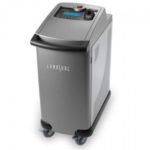LASER HAIR REMOVAL – Q & A
How many treatments will I need?
The amount of treatments depends on many variables such as: your hair’s thickness, the area treated and your hair’s growth cycle. Due to this, the amount of treatments required varies from client to client.
Not all hairs are actively growing at the same time and actually go through three distinct phases: growth, regression, and resting. Laser hair removal works by disabling the hair that is principally in the active growth phase at different times. Additional treatments may be necessary to destroy all of the hair follicles in a given area.
What do the laser treatments feel like?
The laser treatment may feel like a mild sting for a fraction of a second. It has a built-in cooling tip that not only helps to protect the skin but also helps to minimize discomfort.
How does laser hair reduction compare with other hair removal methods?
Shaving, waxing, and creams are all temporary methods, which must be repeated on a frequent basis. Our laser treatment offers permanent hair reduction for lasting results.
How does laser hair reduction compare with Electrolysis?
Electrolysis is a tedious, invasive, and painful process that involves inserting a needle into each individual hair follicle and delivering an electrical charge to them one at a time. Electrolysis often requires years of treatments at regular intervals. By delivering light energy to hundreds of hair follicles, our laser effectively treats an area in just seconds that would take over an hour with Electrolysis.
Is it permanent?
Treatment results may vary among clients. Our laser is cleared by the FDA for permanent hair reduction. The FDA defines permanent hair reduction as the long term, stable reduction in the number of hairs re-growing after a treatment regime.
How does laser hair reduction work?
The laser hair removal system emits light that is absorbed by the pigment located in the hair follicle. The laser is pulsed for only a fraction of a second. The duration of each pulse is just long enough to damage the follicle, while the system’s unique cooling hand piece helps protect the skin by conductive cooling during the laser energy delivery.
What happens after the laser hair reduction treatment?
Following the laser hair removal treatment, you can return to your normal activities right away. The treated area may appear a bit red and swollen. The use of sunscreen is recommended on any treated areas exposed to the sun. Three to seven days after treatment, you may experience what seems to be re-growth of hair. Actually, most of these hairs are being shed as a result of your treatment. Between treatments you should not wax or tweeze your hair, but it is permissible to shave.
What are the possible side effects of laser hair removal?
Although patients experience few side effects with laser hair removal, the most commonly noticed are slight reddening and local swelling of the skin. These effects are typically short lasting. In rare instances, blistering may occur. Consult with your Timeless medical professional for complete information on the benefits and risks of treatment.
What areas can be treated?
Laser hair removal can remove hair from all areas of the body including the face, arms, underarms, back, and legs. It can also treat sensitive areas such as the upper lip, chest, nipples, and bikini line.
Does laser hair reduction work on tanned/different skin colors?
Laser hair removal safely and effectively treats all skin types (Fitzpatrick Skin Types I-VI) as well as tanned skin. For darker skin types and people with tans, appropriate fluences are generally lower and appropriate pulse widths are generally longer to prevent damage to the epidermis. When using the appropriate treatment parameters, people with all skin types can benefit from laser hair removal.
Why choose the Cynosure Apogee Elite hair removal system over other laser hair reduction systems?
In the past, the energies used in laser hair removal procedures prevented people with certain hair and skin colors from receiving treatments as they could only treat extremely light skin with extremely dark hair. The Cynosure Apogee Elite contains two laser systems – a 755 nm Alexandrite laser and a high powered 1064 nm Nd:YAG laser – these are the most optimal wavelengths for hair removal.
certain hair and skin colors from receiving treatments as they could only treat extremely light skin with extremely dark hair. The Cynosure Apogee Elite contains two laser systems – a 755 nm Alexandrite laser and a high powered 1064 nm Nd:YAG laser – these are the most optimal wavelengths for hair removal.
By providing two different wavelengths, the Apogee Elite laser can be used to treat patients with all types of skin. The addition of the YAG laser allows us to treat patients of darker skin types for excessive hair growth, especially of the face, arm pits and bikini lines. Patients with pseudofolliculitis (razor bumps) on the beard, face or neck now have this option to consider.